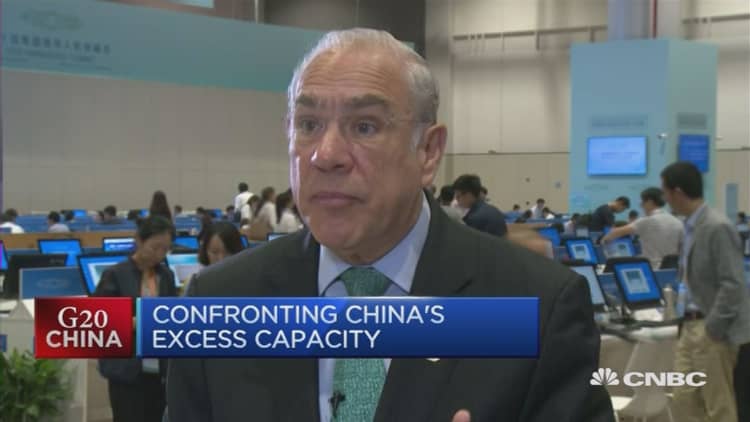A lot of major investors want clues on China's economic "transition," and many analysts say the country's steel sector is the one to watch.
Steel is seen as emblematic of the worst of China's economy: A heavily state-supported manufacturing industry that is deep in debt, influenced by Beijing, and which dumps its excess production onto other countries' markets, distorting prices around the world and crushing non-Chinese competitors.
"Steel is still useful because it's essentially a reform indicator," said Brian Jackson, senior economist at IHS Markit in Beijing.
This week, the G20 meeting ended in Hangzhou, China, with the multinational organization calling for cuts in global steel capacity. The G20 did not specifically name China, but the country accounts for about half the world's steel production — up from roughly a third in 2008.

Chinese companies ramped up capacity several years ago in anticipation of a demand surge that didn't materialize completely, resulting in mounting losses for the industry in China. For the country's steel companies that issue bonds, total losses exploding from 678 million yuan ($101.7 million) in 2014 to 150 billion yuan ($22.5 billion) in 2015, according to China data firm Wind Information.
Wind data also showed that for those steel companies, debt holdings have an average expiration of just 18 months from now, and 82 percent of that debt issuance is being used to pay off old debt rather than directly supporting business operations. Other parts of China's economy have their own struggles with debt, but the steel sector has the highest proportion of debt rollover and the shortest average maturity.
The dominance of short-term loans reflects banks' view of high risk in the steel sector, said Jiming Zou, vice president and senior analyst at Moody's in Shanghai.
Moody's has had a negative outlook on Asia's steel industry — including India, Japan and others — since July 2015, given slowing demand from China's manufacturing and property sectors, and overcapacity that keeps steel prices low and hurting profits.
Signs of progress?
Source: China Iron & Steel Association, Moody's Investors Service projection
"There's little doubt that this is a big issue," Jackson said. "If this was a strictly private sector … then you'd have a debt crisis on your hands."
The difference for China is the government's control of the economy, making the steel sector an area to watch not necessarily for imminent collapse but as a sort of litmus test.
China's government is in the middle of a massive effort to transition the economy from a manufacturing-based one to a consumption-driven one. While doing so, authorities must manage a delicate balance between cutting back the loss-making steel industry and maintaining social stability with jobs and tax revenue for the governments in those regions.
Recent headlines have appeared to indicate Chinese progress in making the steel sector more efficient. Dongbei Special Steel defaulted on a short-term note earlier this year. The number of firms in the broad ferrous smelting and pressing sector fell by more than 1,500 between 2012 and 2016, with the majority in iron and steel smelters, according to IHS Economics.
This summer, steel giants Baosteel and Wuhan Iron & Steel also said they are in talks to restructure together, potentially uniting the world's fifth and eleventh-largest steel companies by production, according to worldsteel.
"By consolidating the steel industry through the merger of large steel companies, they can reduce capacity and improve the competitiveness of the steel industry," Moody's Zou said.
But as a recent surge in government lending to the industry tapers off, and as profitability falls, Zou and other strategists expect prices to go only lower from here.
"The medium-term outlook is negative," said Atul Lele, chief investment officer at Deltec International. "As that stimulus washes through, there will be less demand."
"The economic transition that was in China was not transitioning as planned because of the stimulus in the steel sector," he said.
'These reforms have literally been pledged for 15 years'
The government's actions in the first half of this year pushed off a potential day of reckoning without alleviating concerns about inefficient, state-owned enterprises in the manufacturing sector. And stimulus failed to support efforts to develop a consumption-driven economy.
Home prices surged in an already overheated property market, while government lending boosted hopes that steel demand would rise. Steel rebar prices jumped to a near two-year high earlier this year, and briefly traded around those levels again in the last few weeks.
And more than two months after initial headlines on restructuring the Chinese steel giants, analysts are still waiting for some kind of combination to move beyond the discussion phase. Meanwhile, most China watchers are skeptical that the G20's focus on addressing overcapacity in steel will see material results. A global forum on the issue proposed by the G20, which would be facilitated by Organisation for Economic Co-operation and Development (OECD), would have a year to in which to return its findings.
China has promised to cut 45 million tonnes in steel capacity this year, and as of July had only reached 47 percent of that goal, according to official reports.
"There is Chinese talk and then there is Chinese action," Leland Miller, founder and president of China Beige Book International, said in an email. "Pushing back against the idea that China will proactively combat overcapacity in the steel sector as it promised is the reality that these reforms have literally been pledged for 15 years with little to show."


